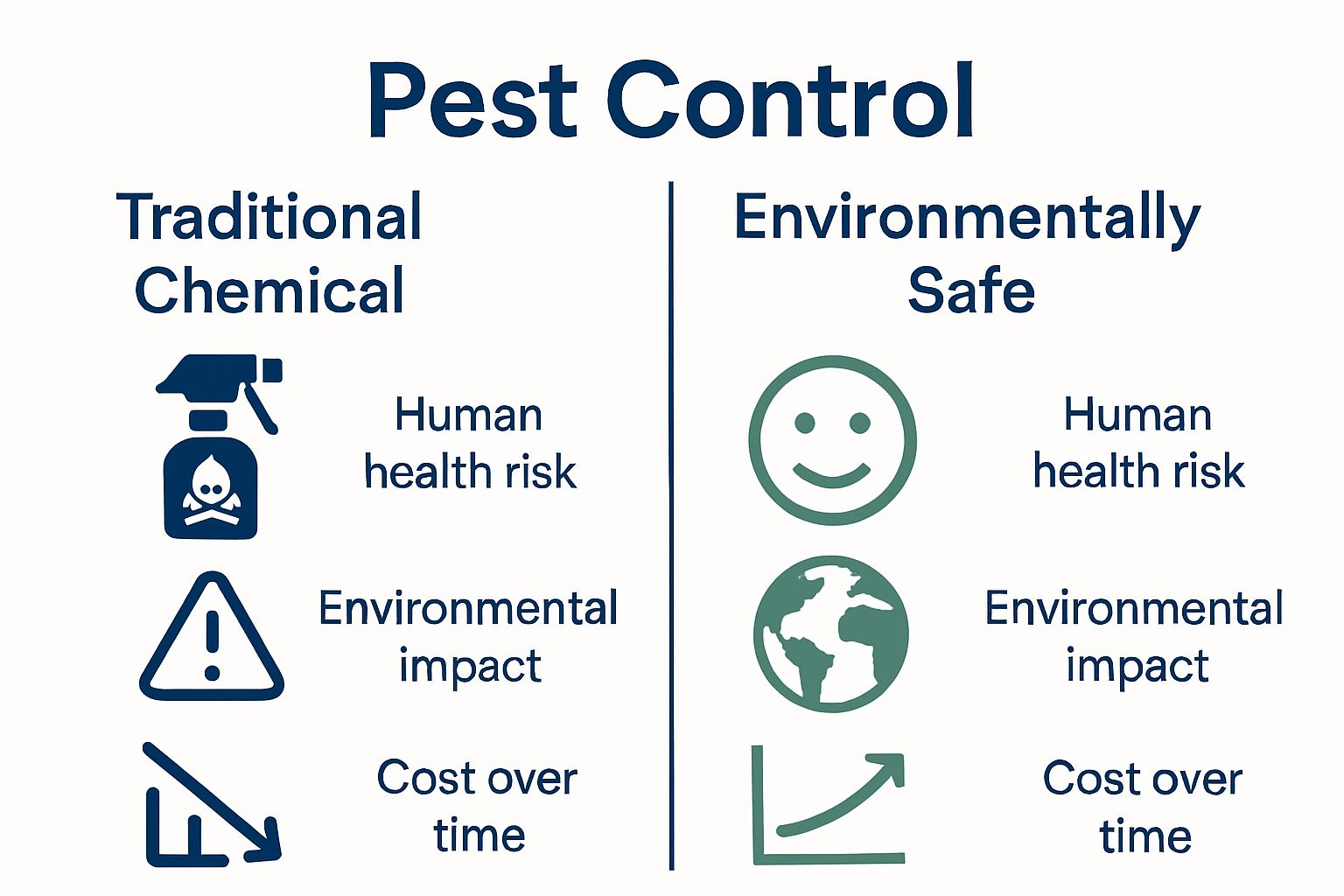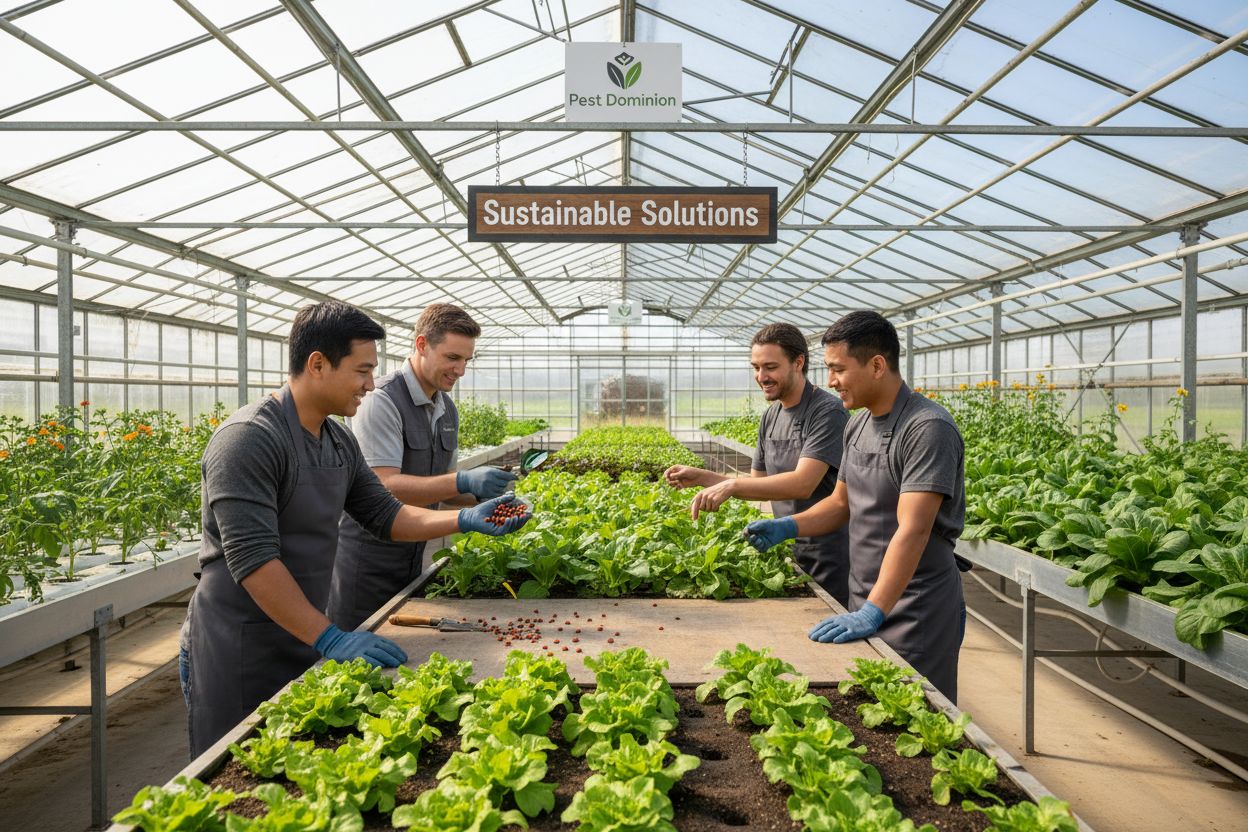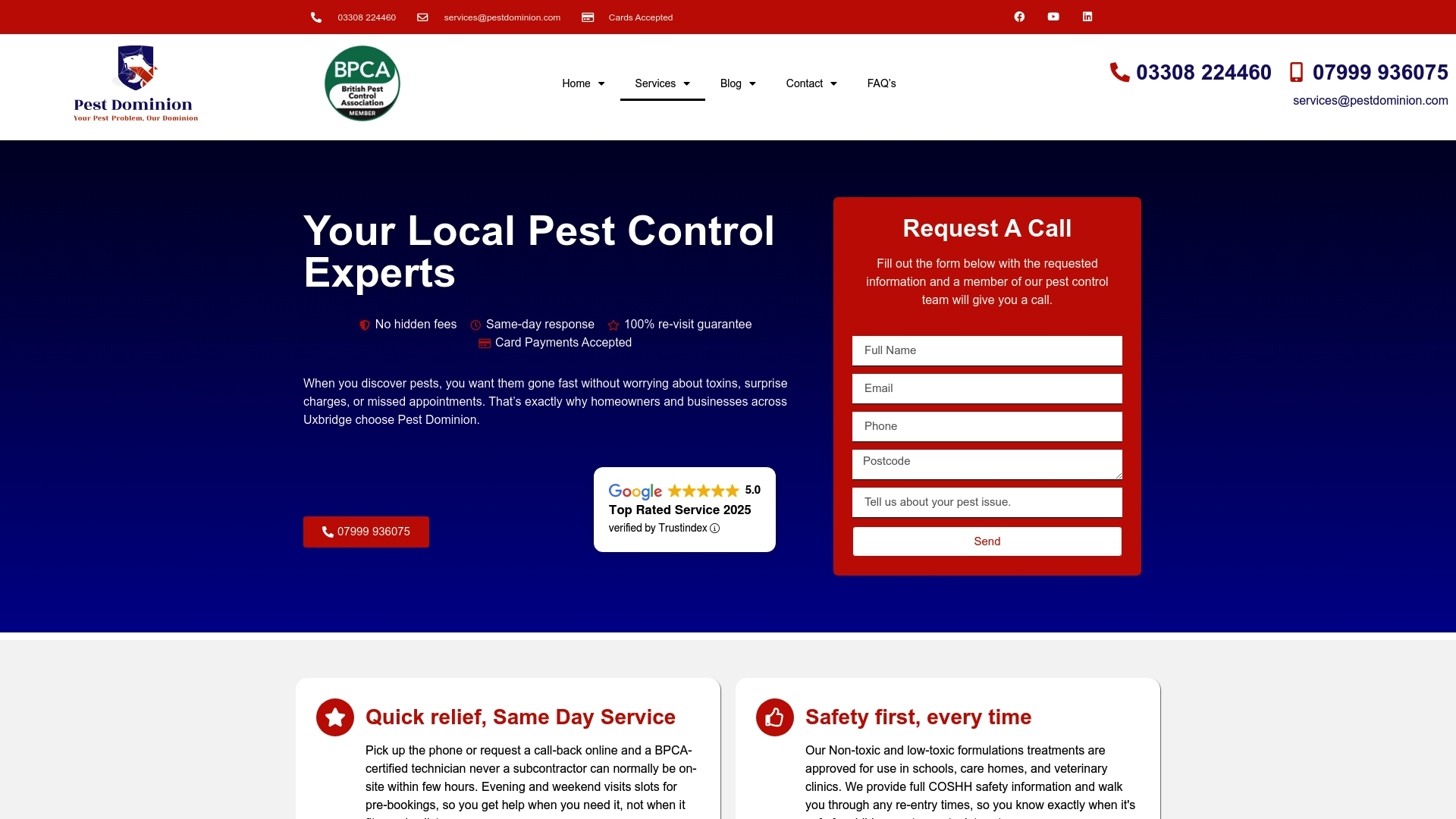People often think pest control means harsh chemicals and risks to the environment. Yet integrated pest management can cut pesticide use by up to 70 percent while still keeping pests in check. The real surprise is that the most effective solutions work with nature rather than against it and they create safer spaces for both people and wildlife.
Table of Contents
- What Is Environmentally Safe Pest Control?
- The Importance Of Choosing Environmentally Friendly Solutions
- How Environmentally Safe Pest Control Works
- Key Concepts Behind Sustainable Pest Management
- Real-World Applications And Benefits
Quick Summary
| Takeaway | Explanation |
|---|---|
| Focus on ecological balance | Prioritise maintaining natural ecosystems and predator-prey relationships during pest control. |
| Implement Integrated Pest Management (IPM) | Use a systematic approach to combine various pest control strategies. |
| Emphasise prevention over reaction | Address underlying causes of infestations instead of just symptoms. |
| Adopt less toxic control methods | Utilize biological and natural deterrents to manage pests sustainably. |
| Recognise economic benefits of sustainability | Understand that sustainable pest management reduces long-term costs and risks. |
What is Environmentally Safe Pest Control?
Environmentally safe pest control represents a progressive approach to managing pest populations that prioritises ecological balance, human health, and sustainable practices. Unlike traditional chemical-intensive methods, this strategy focuses on minimising environmental impact while effectively addressing pest challenges. According to EPA guidelines on safe pest control, these methods aim to protect both human health and surrounding ecosystems.
Core Principles of Environmentally Responsible Pest Management
Environmentally safe pest control operates on several foundational principles that distinguish it from conventional approaches. These principles ensure comprehensive pest management with minimal ecological disruption:
- Biological Balance: Maintaining natural predator-prey relationships and ecosystem stability
- Minimal Chemical Intervention: Using targeted, low-toxicity treatments
- Prevention-First Strategy: Addressing root causes of pest infestations
Key strategies involve understanding pest behaviours, habitat modifications, and employing natural deterrents rather than blanket chemical applications. By learning more about our non-toxic pest control solutions, property owners can explore holistic approaches that protect both their premises and the environment.
Integrated Pest Management Techniques
Integrated Pest Management (IPM) serves as the cornerstone of environmentally safe pest control. This systematic approach combines multiple strategies to manage pest populations effectively:
- Comprehensive site assessment
- Identifying specific pest species and behaviour patterns
- Implementing targeted, least-invasive control methods
- Continuous monitoring and adaptive management
Professional pest control services utilising IPM techniques can significantly reduce environmental impact while maintaining high effectiveness in pest elimination.
The following table summarises key techniques of Integrated Pest Management (IPM) and their roles in environmentally safe pest control.
| IPM Technique | Description | Primary Benefit |
|---|---|---|
| Site Assessment | Evaluating the environment and pest pressures | Enables targeted interventions |
| Pest Identification | Recognising species and understanding behaviour | Prevents unnecessary treatments |
| Targeted Control Methods | Using the least invasive, most effective approaches | Reduces chemical reliance |
| Continuous Monitoring | Regularly tracking pest activity and changes | Supports adaptive management |
| Adaptive Strategies | Adjusting methods based on results and conditions | Ensures ongoing effectiveness |
The goal is not total eradication but balanced, sustainable pest management that respects natural ecological systems.
The Importance of Choosing Environmentally Friendly Solutions
Environmentally friendly pest control solutions represent more than just a contemporary trend; they are a critical response to the complex ecological challenges facing our modern world.
 By selecting sustainable pest management approaches, individuals and businesses can contribute significantly to broader environmental protection efforts while safeguarding human health. Scientific research from the Environmental Protection Agency consistently highlights the long-term benefits of adopting environmentally responsible pest control strategies.
By selecting sustainable pest management approaches, individuals and businesses can contribute significantly to broader environmental protection efforts while safeguarding human health. Scientific research from the Environmental Protection Agency consistently highlights the long-term benefits of adopting environmentally responsible pest control strategies.
Health and Environmental Protection
Traditional chemical pest control methods often introduce harmful substances into our immediate living and working environments. Environmentally friendly solutions mitigate these risks by:
- Reducing exposure to toxic chemicals
- Minimising potential health hazards for humans and pets
- Preventing contamination of water sources and soil
- Preserving beneficial insect populations
By exploring our comprehensive pest management approaches, property owners can understand how sustainable techniques protect both immediate and long-term environmental health.
Economic and Ecological Benefits
Choosing environmentally safe pest control is not just an ecological decision but a smart economic strategy. Sustainable pest management approaches offer substantial advantages:
- Lower long-term treatment costs
- Reduced risk of chemical resistance in pest populations
- Maintenance of natural biodiversity
- Enhanced ecosystem resilience
Professional pest control services that prioritise environmentally friendly methods demonstrate a commitment to responsible resource management and sustainable practices. The goal extends beyond mere pest elimination to creating harmonious, balanced environments that support both human needs and ecological integrity.
How Environmentally Safe Pest Control Works
Environmentally safe pest control operates through a sophisticated, multi-layered approach that transforms traditional pest management strategies. Unlike conventional methods that rely heavily on chemical interventions, this approach prioritises understanding pest ecosystems, preventing infestations, and using targeted, minimal-impact solutions. According to Integrated Pest Management guidelines, the fundamental goal is to manage pest populations with the least possible harm to human health and the environment.
Comprehensive Ecosystem Assessment
The first stage of environmentally safe pest control involves a detailed ecological evaluation of the specific environment. Pest control professionals conduct thorough investigations to understand:
- Specific pest species present
- Underlying factors contributing to pest proliferation
- Natural predator relationships
- Structural and environmental vulnerabilities
This diagnostic approach allows for precise, targeted interventions that address root causes rather than merely treating symptoms. Our ant control strategies exemplify this nuanced approach to pest management.
Natural and Biological Control Methods
Environmentally safe pest control leverages natural biological mechanisms to manage pest populations. These sophisticated strategies include:
- Introducing natural predators
- Using biological control agents
- Implementing pheromone-based disruption techniques
- Creating habitat modifications that discourage pest settlement
These methods work with nature’s inherent balance, reducing reliance on chemical treatments and promoting long-term ecological stability. Professional pest control services skilled in these techniques can effectively manage pest populations while minimising environmental disruption.
Key Concepts Behind Sustainable Pest Management
Sustainable pest management represents an advanced ecological approach that transcends traditional reactive pest control methods. This holistic strategy integrates scientific understanding, environmental consciousness, and strategic intervention to create balanced, long-term solutions for pest challenges. Scientific research published by the National Pest Management Association emphasises the critical importance of understanding ecosystem dynamics in effective pest management.
Ecological Interdependence and Balance
The foundational principle of sustainable pest management recognises the intricate interconnectedness of ecological systems. Pest control professionals must comprehend complex relationships between:
- Species interactions
- Environmental conditions
- Habitat characteristics
- Natural predator-prey dynamics
By understanding these nuanced ecological networks, professionals can develop interventions that minimise ecosystem disruption. Our recommended pest prevention products demonstrate how strategic, targeted approaches can effectively manage pest populations while maintaining environmental integrity.
Preventative and Adaptive Strategies
Sustainable pest management prioritises proactive prevention over reactive treatment. This approach involves continuous monitoring, analysis, and adaptive strategies that:
- Identify potential pest vulnerability zones
- Implement structural and environmental modifications
- Utilise biological control mechanisms
- Develop long-term resilience against pest proliferation
Professional pest management services employing these sophisticated techniques can create comprehensive, environmentally responsible solutions that protect both human environments and natural ecosystems. The ultimate goal extends beyond mere pest elimination to establishing harmonious, balanced living spaces.
Real-World Applications and Benefits
Environmentally safe pest control has transitioned from theoretical concept to practical solution across multiple sectors, demonstrating tangible benefits for businesses, agricultural systems, and residential environments. The implementation of sustainable pest management strategies represents a significant advancement in ecological responsibility and resource management. UK agricultural research highlights the substantial positive outcomes of adopting environmentally conscious pest control approaches.
Sector-Specific Sustainable Solutions
Different industries are experiencing transformative results by implementing environmentally safe pest management techniques.
 Key sectors witnessing remarkable improvements include:
Key sectors witnessing remarkable improvements include:
- Agriculture: Enhanced crop protection without chemical contamination
- Food Service: Maintaining hygiene standards through natural pest deterrence
- Healthcare Facilities: Reducing chemical exposure while ensuring sterile environments
- Hospitality: Creating guest-friendly spaces without harmful pesticide residues
Strategic implementation of these techniques allows organisations to balance operational efficiency with environmental stewardship. Our comprehensive pest prevention strategies demonstrate how targeted, eco-friendly approaches can deliver exceptional results across diverse environments.
Economic and Environmental Advantages
Sustainable pest management offers multifaceted benefits that extend beyond immediate pest control. Organisations adopting these methods experience significant advantages:
- Reduced long-term treatment expenses
- Minimised environmental contamination risks
- Enhanced ecosystem preservation
- Improved public perception and corporate sustainability credentials
Professional pest control services specialising in environmentally safe techniques provide organisations with sophisticated, responsible solutions that protect both human health and ecological systems. By prioritising intelligent, adaptive strategies, businesses can achieve comprehensive pest management while contributing to broader environmental conservation efforts.
Choose Peace of Mind with Environmentally Safe Pest Control in Slough
If you are worried about the health risks and environmental impact of traditional pest control, you are not alone. The article you just read highlighted the importance of minimising chemical intervention and preserving ecological balance while keeping your home or business pest-free. At Pest Dominion Limited, we address these challenges by using targeted, environmentally responsible methods that protect your family, staff, and local wildlife. Discover how our Integrated Pest Management solutions deliver both effectiveness and sustainability for properties in Slough and the surrounding areas. You can read more about the principles that set our approach apart by visiting our homepage.

Ready to experience safer living without compromise? Our accredited local team is known for clear communication, rapid response, and proven results. Make the environmentally friendly choice by learning about our comprehensive pest control services, or explore our personalised non-toxic pest solutions. For tailored advice or to schedule a visit, take action now by contacting us directly at Pest Dominion Limited. The time to choose a safer pest control solution for your property is today.
Frequently Asked Questions
What are the main advantages of choosing environmentally safe pest control?
Choosing environmentally safe pest control helps protect human health, minimise environmental contamination, and sustain beneficial insect populations. Opt for these methods to ensure that both your living space and the surrounding ecosystem remain safe and healthy.
How does environmentally safe pest control differ from conventional methods?
Environmentally safe pest control prioritises ecological balance through minimal chemical intervention, focusing on prevention and natural pest management strategies. Consider implementing an integrated pest management approach that targets root causes rather than merely treating symptoms.
Below is a comparison table outlining the main differences between environmentally safe pest control and conventional methods, providing a quick reference for understanding their contrasting approaches and benefits.
| Aspect | Environmentally Safe Pest Control | Conventional Chemical Pest Control |
|---|---|---|
| Chemical Usage | Minimal, targeted, low-toxicity interventions | Frequent use of broad-spectrum chemicals |
| Focus | Prevention, ecosystem balance | Immediate eradication, symptom-based |
| Impact on Non-target Species | Preserves beneficial insects and wildlife | Higher risk of collateral damage |
| Long-term Effectiveness | Promotes resilience and reduces future infestations | Increased risk of resistance and repeated treatments |
| Environmental Contamination | Low, protects soil and water sources | High potential for pollution |
| Human and Pet Safety | Reduced exposure to harmful substances | Greater risk from toxic residues |
What steps can I take to implement environmentally safe pest control at home?
To implement environmentally safe pest control, start by assessing your environment for pest vulnerabilities and modifying habitats to deter pests. You might see a reduction in pest populations within 30-60 days by using natural deterrents and biological control methods.
How can I ensure the effectiveness of environmentally safe pest control methods?
Ensure effectiveness by regularly monitoring pest populations and adapting your strategies based on observed changes. Keep a log of pest activity to evaluate the success of your interventions and make adjustments as necessary.
What is the role of prevention in environmentally safe pest management?
Prevention plays a crucial role in environmentally safe pest management by addressing the underlying factors that lead to infestations. Focus on structural modifications and habitat changes to create a less inviting environment for pests, which can significantly reduce the need for chemical treatments.

